5th December 2007
 Sunday, December 16, 2007 at 10:20AM
Sunday, December 16, 2007 at 10:20AM
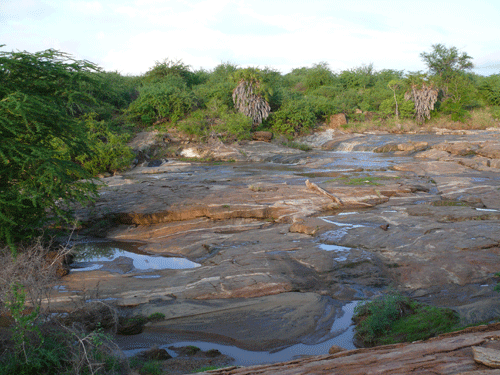
By 6.30am, we were back at the “Crocodile Falls” on the Mtito River (above). There was just one huge crocodile there, lying in wait at the base of one of the falls, his head under the water, his huge reptilian body unmoving. Apart from that, it was just the birds who were busy as usual. The weavers are frantically active on their nests, and the Diederiks Cuckoos were there in force again, waiting for their chance parasitize the weaver nests at the first opportunity. The Kingfishers were there too – the Pied and the Brown-hooded. The Pied Kingfisher was actively fishing, while the Brown-hooded just seemed to enjoying the morning sun.
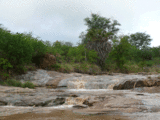
Crocodile lying below the bottom falls, with his head under the water (click to enlarge and look carefully to find him!)
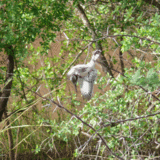
Pied Kingfisher launches into a dive, heading for a hapless fish
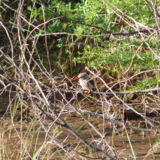
A Brown-hooded Kingfisher
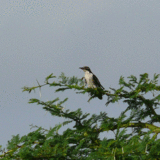
Diederik Cuckoo on the lookout for a weaver's nest to parasitize
We watched the huge crocodile for an hour, but in all that time, it only moved once to lift its head up above the water. Apart from that, it kept its head hidden from us under the falls. (Surely it must have had its nostrils above water behind the falls, where it could breathe?) We knew that when it had its head underwater, it would not be able to see us, so we crept down to the water’s edge – to within 10 yards of the huge, prehistoric reptile, and there we waited with baited breath, and not a little tense, it has to be said!
Finally the crocodile lifted its massive head, and on seeing us there at the water’s edge, climbed up the falls and slid slowly into a deeper pool and out of sight completely.
What a sense of elation! When you just know in your bones that you have captured the most dramatic photographic images that you could ever have wished for! I could hardly wait to get back to the house and download my photos of the mighty reptile clambering up the falls, the water rushing over it, the animal’s eyeballs trained back towards us, watching our every move and then – as if it had never been there at all – vanishing into the pool above without so much as a splash.
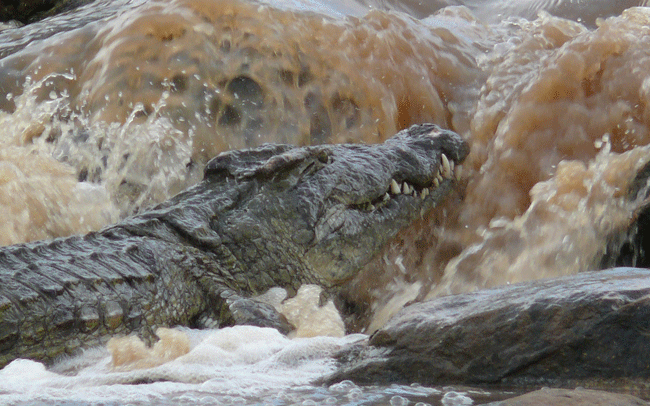
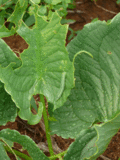
Click to enlarge
On a somewhat less dramatic note, having said in an earlier entry that we had never seen anything eat the “seagrass / cabbage plant”, we saw caterpillars on the plants today, munching their way through the broad leaves, creating intriguing patterns…still no sign of a flower on them though.
A flock of Vulturine Guineafowl was up on the airstrip on the neighbouring property this evening, and I managed to photograph one passing a Black-faced Sandgrouse. The Black-headed Plovers were up there again too, as usual, and a herd of impala. Two young males, boyed up by the rain and all the greenery no doubt, were sparring – playful games preparing them for more serious bouts in adulthood. The large Baobab tree at the top end of the strip was looking gorgeous in all its green finery, illuminated in the evening light and hosting a noisy cacophony of Orange-bellied Parrots and a serene Pale Chanting Goshawk. When you circumnavigate the tree, you realise that it has a hole right through its middle, which makes for an interesting photograph or two. The Baobabs really are extraordinary trees.

Young Impala sparring (click to enlarge any image)
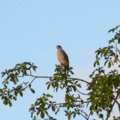
Pale Chanting Goshawk

Orange-bellied Parrots

Black-headed Plovers
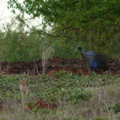
Black-faced Sandgrouse & Vulturine Guineafowl

Hole through Baobab trunk
More Pictures:
In Close-Up: More pictures of the massive crocodile lying in wait on the Mtito River...
More Kingfisher Photos, and other resident birds of Kulafumbi...
In Pictures: Migrant Birds visiting Kulafumbi once a year...
Caterpillars and other insect images...
More photos of Impala, and other resident antelope species...
Discover more of Kulafumbi's amazing trees in my December Tree Watch...





Reader Comments